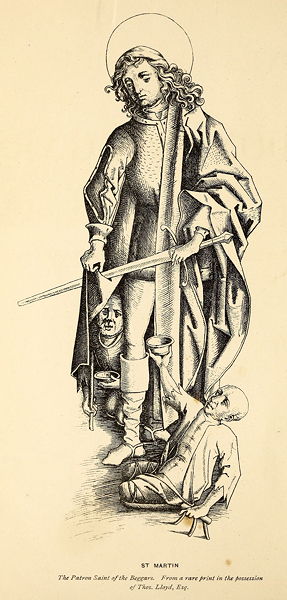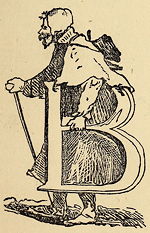Transcriber's Note.
There are thirty plates, located at the end of the text, that depictindividuals described in it. They have been moved to follow the textthat describes them. They are annotated "London Published as theAct directs [date] by J. T. Smith No. 4 Chandos St Covent Garden."
Inconsistencies in hyphenation and spelling have been retained.

ST MARTIN
The Patron Saint of the Beggars. From a rare print in the possession of Thos. Lloyd, Esq.
LIVES OF FAMOUS
LONDON BEGGARS,
WITH
FORTY PORTRAITS OF THE MOST REMARKABLE.
DRAWN FROM LIFE BY
JOHN THOMAS SMITH.

London:
DIPROSE AND BATEMAN, SHEFFIELD STREET,
Lincoln's Inn Fields.
PREFACE.
Mr Granger, at the close of his Biographical History of England, says, "I shall conclude this volume withobserving, that Lord Bacon has somewhere remarked, that biography has been confined within too narrow limits; asif the lives of great personages only deserved the notice of the inquisitive part of mankind. I have, perhaps, in theforegoing strictures extended the sphere of it too far. I began with Monarchs, and have ended with Ballad-Singers,Chimney-Sweepers, and Beggars. But they that fill the highest and the lowest classes of human life, seem, in manyrespects, to be more nearly allied than even themselves imagine. A skilful anatomist would find little or no difference, indissecting the body of a king and that of the meanest of his subjects; and a judicious philosopher would discover asurprising conformity, in discussing the nature and qualities of their minds."

Beggary,of late, particularly for the last six years, hadbecome so dreadful in London, that the more activeinterference of the legislature was deemed absolutelynecessary; indeed, the deceptions of the idle and sturdywere so various, cunning, and extensive, that it was inmost instances extremely difficult to discover the realobject of charity from the impostor.
Concluding, therefore, from the reduction of themetropolitan beggars, that several curious characters woulddisappear by being either compelled to industry, or topartake of the liberal parochial rates provided for themin their respective workhouses, it occurred to the authorof the present publication, that likenesses of the mostremarkable of them, with a few particulars of their habits,would not be unamusing to those to whom they havebeen a pest for several years.
In order to convince his readers that he does not stand alone as a delineator ofmendicants, he begs leave to observe, that several of the very first-rate artists havestudied from them.
Michael Angelo Buonarotti often drew from beggars; and report says, that in theearly part of his life, when he had not the means of paying them in money, he wouldmake an additional sketch, and, presenting it to the party, desire him to take it to someparticular person, who wou